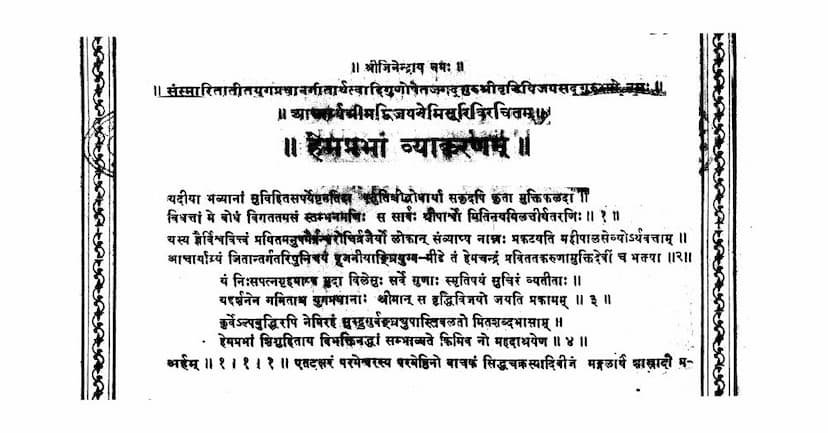Hemprabha Vyakaranam
Added to library: September 1, 2025

Summary
The Jain text "Hemprabha Vyakaranam" by Acharya Shri Vijaynemisurivaravirachitam is a comprehensive grammar work, likely in Sanskrit, focusing on the nuances of the Jain tradition'e linguistic and philosophical underpinnings. The provided text is a section of this work, likely dealing with various aspects of Jain grammar and language, possibly related to the classification of words, their grammatical forms, and their usage in the context of Jain philosophy.
Here's a breakdown of the key themes and concepts discernible from the provided pages, even without a direct translation:
Overall Nature of the Text:
- Grammatical Focus: The title "Hemprabha Vyakaranam" itself indicates a grammatical treatise. The text delves into rules, definitions, and classifications of linguistic elements, suggesting a structured approach to language.
- Jain Context: The presence of "Jain Education International" and the opening invocation "|| श्रीजिनेन्द्राय नमः ||" clearly place this work within the Jain tradition. The mention of "Shri Jinendra" and "Shri Vriddh Vijay Sadguru" points towards a devotional and reverent tone, typical of Jain religious literature.
- Comprehensive Scope: The mention of various grammatical chapters like "स्वरसन्ध्यधिकार" (Vowel Sandhi), "असन्धिप्रकरण" (Non-Sandhi rules), "व्यञ्जनसन्धि" (Consonant Sandhi), "रेफसन्धि" (Ref Sandhi), "स्यादिसन्धि" (Syad-vadi Sandhi), "स्वरान्ताः पुल्लिङ्गाः" (Vowel-ending Masculine Nouns), "स्वरान्ताः स्त्रीलिङ्गाः" (Vowel-ending Feminine Nouns), "स्वरान्ता नपुंसकलिङ्गाः" (Vowel-ending Neuter Nouns), "व्यञ्जनान्ताः पुल्लिङ्गाः" (Consonant-ending Masculine Nouns), "व्यञ्जनान्ताः स्त्रीलिङ्गाः" (Consonant-ending Feminine Nouns), "व्यञ्जनान्ताः नपुंसकलिङ्गाः" (Consonant-ending Neuter Nouns), "युष्मदस्मत्प्रक्रिया" (Pronoun Processing), "अव्ययानि" (Indeclinables), "स्त्रीप्रत्ययाः" (Feminine Suffixes), "कारकाणि" (Karakas/Case Relations), "समासप्रकरणम्" (Compound Rules), "तद्धिताः" (Taddhita Suffixes), "कृदन्तप्रक्रिया" (Krit Suffixes), and "उणादयः" (Unadi Suffixes) indicates a vast coverage of Sanskrit grammar, tailored to the needs of Jain scholars.
Key Grammatical Concepts Covered (based on headings and recurring terms):
- Sandhi (Phonetic Combination): The text systematically explains rules for vowel sandhi (स्वरसन्धि), non-sandhi (असन्धि), consonant sandhi (व्यञ्जनसन्धि), and ref sandhi (रेफसन्धि). The emphasis on sandhi rules is crucial for correct pronunciation and word formation in Sanskrit.
- Word Declension (Nouns): Chapters dedicated to vowel-ending and consonant-ending nouns in masculine, feminine, and neuter genders (स्वरान्ताः पुल्लिङ्गाः, स्वरान्ताः स्त्रीलिङ्गाः, स्वरान्ताः नपुंसकलिङ्गाः, व्यञ्जनान्ताः पुल्लिङ्गाः, व्यञ्जनान्ताः स्त्रीलिङ्गाः, व्यञ्जनान्ताः नपुंसकलिङ्गाः) demonstrate a detailed analysis of noun declensions, which are fundamental to Sanskrit grammar.
- Pronouns (युष्मदस्मत्): A specific section on the processing of pronouns like "you" (युष्मद्) and "I" (अस्मद्) indicates attention to personal pronouns and their grammatical transformations.
- Indeclinables (अव्ययानि): The presence of a chapter on indeclinables highlights words that do not change their form, which are essential for understanding sentence structure and meaning.
- Suffixes (प्रत्यय): The extensive coverage of feminine suffixes (स्त्रीप्रत्ययाः), taddhita suffixes (तद्धिताः), krit suffixes (कृदन्तप्रक्रिया), and unadi suffixes (उणादयः) shows the text's commitment to explaining how words are formed by adding various suffixes to roots and bases. This is a major part of Sanskrit grammar.
- Karakas (Case Relations): A detailed discussion on Karakas (कारकाणि) is evident, which explains the grammatical relationships between nouns and verbs in a sentence (e.g., subject, object, instrument, dative, ablative, genitive, locative). This is vital for understanding sentence construction and meaning.
- Samasa (Compound Words): The comprehensive chapter on Samasa (समासप्रकरणम्) indicates a focus on how words can be combined to form compound words, a characteristic feature of Sanskrit. Different types of Samasa (e.g., Tatpurusha, Dvigu, Bahuvrihi, Avyayibhava, Dvandva) are likely discussed.
- Vowel and Consonant Rules: The detailed sections on Vowel Sandhi (स्वरसन्धि) and Consonant Sandhi (व्यञ्जनसन्धि) indicate a meticulous approach to phonetics and the rules governing the changes that occur when words are joined.
- Philosophical Terms: The mention of "Syadvada" in the context of sandhi ( स्याद्वादात्) is significant, as Syadvada is a core tenet of Jain philosophy, emphasizing the multi-faceted nature of reality and the limitations of absolute assertion. This suggests the grammar is not just about linguistic rules but also about conveying philosophical concepts through language.
Author and Publisher:
- Author: Acharya Shri Vijaynemisuri (आचार्यश्रीमद्विजयनेमिसूरिविरचितम्) is identified as the author.
- Publisher: The publisher is stated as "Unknown" (Publisher: Unknown).
Overall Purpose and Significance:
The "Hemprabha Vyakaranam" appears to be a significant work for students and scholars of Jainism and Sanskrit grammar. It likely aims to:
- Provide a foundational understanding of Sanskrit grammar within a Jain philosophical framework.
- Explain the correct usage of language for accurately interpreting and articulating Jain scriptures and teachings.
- Preserve and disseminate knowledge of grammar, which is considered a foundational Veda in Indian traditions, including Jainism.
- Highlight the interconnectedness of language and philosophy, especially through the integration of Jain concepts like Syadvada.
Without a direct translation, it's challenging to provide a word-for-word summary, but the structure and the terminology strongly suggest a scholarly and detailed grammatical work deeply rooted in Jain tradition.